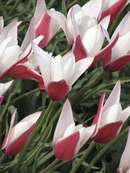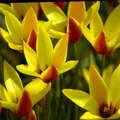Species tulips (mini-tulips) are tough! In the wild they grow in the winter environs and dry soils of Central Asia, the Middle East, and China (USDA hardiness zones 3-7). In gardens they prosper for many years in full to partial sun and in average soil with good drainage.
Over the centuries mini-tulips have been improved. Color choices include red, bright yellow, orangey-red, pink, orchid, white, and bi-colors. Bloom times vary from early thru late spring.
Mini-tulips partner well with low-growing varieties of stonecrops (Sedum), which also thrive in subpar soils and hot, dry sites. Avoid planting in poorly drained or soggy soils. Voles may become a serious pest.
Plant mini-tulips at the same time you’re sowing other spring-blooming bulbs from October thru December when average day temperatures are in low 4oºF range and the ground is not frozen. Bury them just 4-5 inches deep. No fertilizer or soil amending is needed.
To maximize their potential to naturalize, do not trim foliage after flowering ends; allow foliage to die back on its own. New bulblets (offsets) and new bulb should develop underground. Mini-tulips suffer in southern U.S. zones if winter soil temps stay too warm to initiate flowers; plants also may germinate weakly and not bloom.
They’re small… so bunch a handful in pockets in flower borders, in rock gardens, along fences or walks. Tuck some around the base of late leafing deciduous trees.
Mr. Brent Heath, Brent and Becky’s Bulbs in Gloucester, VA, provided the following info:
T. sylvestris – stoloniferous, naturalizes in light shade, yellow, sweet fragrant outwardly facing flowers.
T. clusiana var. chrysantha –high desert mountain type from Iran to northern India is perfect for rock gardens; varieties ‘Lady Jane’ and ‘Cynthia’.
T. whatalei – orange cup-shape flowers in light shade (South) to full sun (North).
T. bakeri – ‘Lilac Wonder’ and ‘Honky Tonk’(soft yellow-pink hybrid) prefer full sun.
T. linifolia – dark red flowers and narrow edged leaves; ideal for sunny rock garden.




 Posted in
Posted in 
